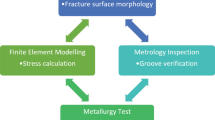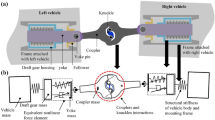Abstract
In practice a coaxial Bragg structure always has an eccentricity between the outer-wall and inner-rod axes. Numerical simulations are carried out to analyze the effect of the eccentricity on the transmission in a coaxial Bragg structure. Results demonstrate that the effect of the eccentricity is minimized and becomes negligible when the phase difference between the outer and inner corrugations is π, no matter if the eccentricity is parallel or oblique.







Similar content being viewed by others
References
A. Yariv, and M. Nakamura, “Periodic Structures for Integrated Optics”, IEEE J. Quantum Electron. QE-13, 233–253, Apr. (1977).
H. Kogelnik, and C. V. Shank, “Coupled-Wave Theory of Distributed Feedback Laser,” J. Appl. Phys. 43, 2327–2335, May (1972).
J. D. Joannopoulos, R. D. Meade, and J. N. Winn, Photonic Crystals Modeling the Flow of Light, New Jersey: Princeton University Press, 1995.
V. L. Bratman, G. G. Denisov, N. S. Ginzburg, and M. I. Petelin, “FEL’s with Bragg reflection resonators: Cyclotron Autoresonance Masers vesus Ubitrons,” IEEE J. Quantum Electronics, QE-19, 282–293, Mar. (1983).
A. J. Palmer, “Coupled-mode theory of overmoded cylindrical metal Bragg-reflectors,” IEEE J. Quantum Electron. QE-23, 65–70, Jan. (1987).
R. B. McCowan, A. W. Fliflet, S. H. Gold, V. L. Granatstein, and M. C. Wang, “Design of a waveguide resonator with rippled wall reflectors for a 100 GHz CARM oscillator experiment,” Int. J. Electron. 65, 463–475, (1988).
R. B. McCowan et al., “The Design of a 100-GHz CARM oscillator experiment,” IEEE Trans. Electron Devices. 36, 1968–1975, Sept. (1989).
C. K. Chong et al., “Bragg reflecors,” IEEE Trans. Plasma Sci. 20, 393–402, Jun. (1992).
S. Alberti et al., “Experimental Study of a 28 GHz High-Power Long-Pulse Cyclotron Autoresonance Maser Oscillator,” Phys. Rev. Lett. 71, 2018–2021, Sept. (1993).
N. S. Ginzburg et al., “The use of a hybrid resonator consisting of one-dimensional and two-dimensional Bragg reflectors for generation of spatially coherent radiation in a coaxial free-electron laser,” Phys. Plasmas. 9, 2798–2802, Jun. (2002).
P. McGrane, I. V. Konoplev, K. Ronald, A. W. Cross and A. D. R. Phelps, “Experimental and theoretical study of constructive and destructive wave interference in a coaxial 1D Bragg structure,” in Joint 29th Int. Conf. Infrared Millimeter Waves and 12th Int. Conf. on Terahertz Electronics Dig., Karlsruhe, pp. 177–178, (2004).
I. V. Konoplev et al., “Progress of the Strathclyde Free Electron Maser experiment using 2D Bragg structure,” Nucl. Instr. and Meth. A. 445, 236–240, (2000).
I. V. Konoplev, P. McGrane, A. W. Cross, K. Ronald, and A. D. R. Phelps, “wave interference and band control in multiconductor one-dimensional Bragg structures,” J. Appl. Phys. 97, 073101-1–073101-7, Mar. (2005).
I. V. Konoplev, P. McGrane, A. D. R. Phelps, A. W. Cross, and K. Ronald, “Observation of photonic band-gap control in one-dimensional Bragg structures”, Appl. Phys. Lett. 87, 121104, (2005).
J. J. Barroso, and J. P. Leite Neto, “Design of coaxial Bragg reflectors,” IEEE Trans. Plasma Sci. 34, 666–672, Jun. (2006).
Y. X. Lai, and S. C. Zhang, “Coaxial Bragg reflector with a corrugated inner rod”, IEEE Microw. Wirel. Compon. Lett.. 17, 328–331, May (2007).
S.-C. Zhang, and M. Thumm, “Gyrokinetic description of the structural eccentricity on the strating current of a coaxial-cavity gyrotron,” Phys. Plasmas. 20, 157–170, (1999).
S.-C. Zhang, and M. Thumm, “Eigenvalue equations and numerical analysis of a coaxial cavity with misaligned inner rod,” IEEE Trans. Microwave Theor. Tech. 48, 8–14, Jan. (2000).
Computer Simulation Technology (CST), User’s Manual 5, in CST-Microwave Studio, (2003).
Acknowledgements
This work was supported mainly by the National Natural Science Foundation of China (No.60471038). The authors would like to express their thanks to Dr. X.-D. Cui for useful discussion on the numerical simulations.
Author information
Authors and Affiliations
Corresponding author
Rights and permissions
About this article
Cite this article
Zhang, SC., Chen, XH. & Lai, YX. Effect of Eccentricity on Transmission in a Coaxial Bragg Structure. Int J Infrared Milli Waves 28, 1043–1050 (2007). https://doi.org/10.1007/s10762-007-9287-8
Received:
Accepted:
Published:
Issue Date:
DOI: https://doi.org/10.1007/s10762-007-9287-8




